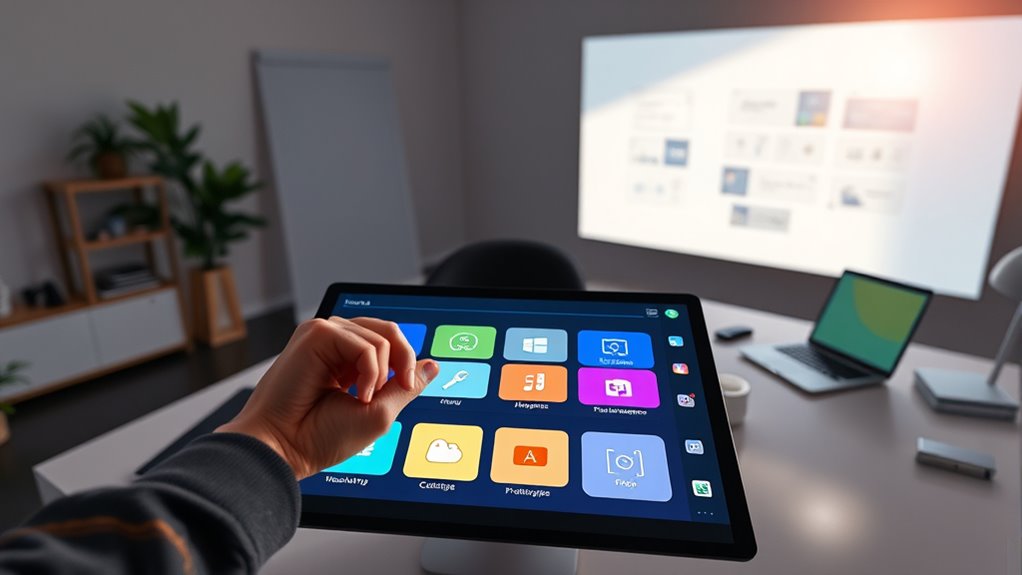Using drag-and-drop visualization tools lets you rapidly create interactive prototypes without coding, helping you test ideas and refine user experiences quickly. These tools streamline your workflow by offering pre-built components and templates, enabling you to make real-time adjustments and gather immediate feedback. They also encourage collaboration, making it easier to share concepts with stakeholders. Keep exploring further to discover how these tools can boost your design process and save time.
Key Takeaways
- Drag-and-drop tools enable quick creation of interactive prototypes without coding, speeding up the design process.
- They facilitate real-time collaboration and easy sharing, improving team feedback and iteration cycles.
- Pre-built components and templates streamline workflows, ensuring consistent and polished user interfaces.
- Rapid prototyping helps identify usability issues early, allowing for user-centered design adjustments.
- These tools support quick testing of ideas, flows, and layouts, saving time and resources in development.

In today’s fast-paced development environment, creating prototypes quickly is essential for testing ideas and gathering feedback. Drag-and-drop visualization tools have revolutionized how you approach prototyping, enabling you to design with speed and flexibility. With these tools, you don’t need to write code or rely on complex software; instead, you can assemble interactive prototypes by simply dragging elements into place. This approach helps you focus on refining user experience because you can experiment with different layouts, flows, and features without getting bogged down in technical details. As a result, you’re able to identify potential issues early and make improvements that enhance overall usability.
Prototyping quickly with drag-and-drop tools accelerates feedback and improves user experience through rapid, flexible design iterations.
One of the main benefits of drag-and-drop tools is how they foster design collaboration. When you’re working with a team—whether it’s designers, developers, or stakeholders—these platforms make it easy to share ideas in real-time. Everyone can see updates instantly, provide feedback, and suggest modifications without lengthy back-and-forths or version control headaches. This immediacy accelerates decision-making and guarantees that the prototype evolves in alignment with your collective vision. Plus, since the tools are often visual and intuitive, team members who aren’t technically inclined can actively participate, enriching the design process with diverse perspectives.
Speed is a critical advantage here. Instead of spending hours or days on detailed mockups, you can create functional prototypes within minutes. This rapid iteration cycle means you can test multiple concepts, user flows, or interface adjustments quickly and efficiently. It’s especially useful for user experience testing because you can observe how users interact with different prototypes and gather feedback almost instantly. Such insights help you fine-tune the design before moving into development, saving time and resources later. As you iterate rapidly, you also cultivate a more user-centered approach, focusing on what truly works best for your audience.
Furthermore, these visualization tools often come with pre-built components, templates, and integrations that streamline your workflow. You don’t need to start from scratch each time; instead, you can customize existing elements to match your project’s needs. This not only speeds up the prototyping process but also maintains consistency in design, which is essential for a polished user experience. With easy sharing options, you can demonstrate prototypes to clients or stakeholders seamlessly, gaining buy-in and aligning expectations early on. Additionally, understanding the types of cookies involved in user data collection can help ensure your prototypes are designed with privacy considerations in mind.
Frequently Asked Questions
Can These Tools Integrate With Existing Development Environments?
Yes, these tools can often integrate with your existing development environments, but you might face some integration challenges. They typically offer customization options to tailor the tools to your workflow, making it easier to connect with other software you use. However, verify you check compatibility and available plugins to smooth out any integration challenges, so your prototyping process remains seamless and efficient within your current setup.
What Are the Limitations of Drag-And-Drop Prototyping?
You might find drag-and-drop prototyping tools limited in design flexibility and customization options. While they’re great for quick ideas, they often restrict your ability to create highly tailored or complex features. You can’t easily implement unique interactions or detailed animations, which can hinder your vision. Additionally, these tools may lack the flexibility to adapt to specific project requirements, making it harder to refine your prototypes beyond basic templates.
How Secure Is Data When Using These Visualization Tools?
Ever wonder how secure your data is with these visualization tools? Your data’s safety depends on strong data encryption and robust access controls. These tools often implement encryption during data transfer and storage, but security varies by platform. Are you confident your access controls restrict data to authorized users only? To protect your information, always verify the platform’s security measures and make sure they follow best practices for data encryption and access management.
Do These Tools Support Collaborative Team Workflows?
Yes, these tools support team collaboration by allowing multiple users to work simultaneously on projects. They often include version control features, so you can track changes and revert to previous versions if needed. This makes coordinating with your team seamless and efficient. You can easily share updates, review changes, and guarantee everyone stays on the same page, speeding up your prototyping process without sacrificing control or clarity.
What Is the Learning Curve for New Users?
You’ll find that the learning curve for new users is generally gentle, thanks to a user-friendly experience and an intuitive onboarding process. Most tools prioritize simplicity, allowing you to quickly grasp core features through guided tutorials and easy-to-navigate interfaces. As a result, you can start creating prototypes faster, with minimal frustration. With consistent use, you’ll become proficient and leverage the full potential of drag-and-drop visualization tools efficiently.
Conclusion
Think of drag-and-drop visualization tools as your trusty compass on a quick voyage. They guide you swiftly through uncharted waters, turning complex ideas into clear maps in mere moments. With these tools, you’re the captain steering your project to shore, avoiding storms of confusion. Embrace their simplicity, and watch your prototypes come to life as smoothly as a sail catching the wind—fast, effortless, and ready to explore new horizons.









